Numerical Investigation of the Characteristics of Erosion in a Centrifugal Pump for Transporting Dilute Particle-Laden Flows
Abstract
:1. Introduction
2. Numerical Model
2.1. Description of Pump Model
2.2. Particle Modeling
2.3. Governing Equations
2.3.1. Governing Equations of Liquid Phase
2.3.2. Governing Equations of Solid Phase
2.3.3. Drag Force Model
2.3.4. Lift Force Model
2.3.5. Models of Pressure Gradient and Virtual Mass Forces
2.3.6. Particle-Particle Collision Model
2.3.7. Turbulence-Particle Interaction Model
2.4. Erosion Model
2.5. Boundary Conditions and Model Setups
2.6. Mesh Verification
3. Model Validation
3.1. Validation of Liquid-Solid Two-Phase Flow in the Pump
3.2. Validation of the Erosion Prediction in a 90° Bend
3.3. Validation of the Erosion Prediction on the Hydraulic Components of Pump
4. Results and Discussion
4.1. Influence of Particle Concentration on the Pump Erosion
4.2. Influence of Particle Size on the Pump Erosion
4.3. Effect of Particle Shape on the Pump Erosion
5. Conclusions
Author Contributions
Funding
Institutional Review Board Statement
Informed Consent Statement
Data Availability Statement
Acknowledgments
Conflicts of Interest
References
- Wu, B.; Wang, X.L.; Liu, H.; Xu, H.L. Numerical simulation and analysis of solid-liquid two-phase three-dimensional unsteady flow in centrifugal slurry pump. J. Cent. South. Univ. 2015, 22, 3008–3016. [Google Scholar] [CrossRef]
- Gandhi, B.K.; Singh, S.N.; Seshadri, V. Performance Characteristics of Centrifugal Slurry Pumps. J. Fluid. Eng. 2001, 123, 271–280. [Google Scholar] [CrossRef]
- Glasby, G.P.; Li, J.; Sun, Z.L. Deep-Sea Nodules and Co-rich Mn Crusts. Mar. Georesour. Geotechnol. 2014, 33, 72–78. [Google Scholar] [CrossRef]
- Llewellyn, R.J.; Yick, S.K.; Dolman, K.F. Scouring erosion resistance of metallic materials used in slurry pump service. Wear 2004, 256, 592–599. [Google Scholar] [CrossRef]
- Ariely, S.; Khentov, A. Erosion corrosion of pump impeller of cyclic cooling water system. Eng. Fail. Anal. 2006, 13, 925–932. [Google Scholar] [CrossRef]
- Sharma, P. Premature failure of ductile iron pump impeller in cooling tower system. J. Fail. Anal. Prev. 2014, 14, 303–306. [Google Scholar] [CrossRef]
- Zhao, B.A.; Yuan, S.B.; Liu, H.B.; Huang, Z.C.; Tan, M.B. Simulation of solid-liquid two-phase turbulent flow in double-channel pump based on Mixture model. Trans. Chin. Soc. Agric. Eng. 2008, 24, 7–12. [Google Scholar]
- Zhang, Y.L.; Li, Y.; Cui, B.L.; Zhu, Z.C.; Dou, H.S. Numerical simulation and analysis of solid-liquid two-phase flow in centrifugal pump. Chin. Soc. Agric. Eng. 2013, 26, 53–60. [Google Scholar] [CrossRef]
- Lin, C.X.; Ebadian, M.A. A numerical study of developing slurry flow in the entrance region of a horizontal pipe. Comput. Fluids 2008, 37, 965–974. [Google Scholar] [CrossRef]
- Pagalthivarthi, K.V.; Gupta, P.K.; Tyagi, V.P.; Ravi, M.R. CFD Prediction of Erosion Wear in Centrifugal Slurry Pumps for Dilute Slurry Flows. J. Comput. Multiph. Flows 2011, 3, 225–246. [Google Scholar] [CrossRef] [Green Version]
- Shen, Z.J.; Li, R.N.; Han, W.; Zhao, W.G.; Wang, X.H. The research on particle trajectory of solid-liquid two-phase flow and erosion predicting in screw centrifugal pump. In Proceedings of the 7th International Conference on Pumps and Fans (icpf2015), Hangzhou, China, 18–21 October 2015; Volume 129, p. 012052. [Google Scholar]
- Huang, S.; Zhou, W.L.; Zhou, J.J.; He, D.P.; Peng, T.Y. Unsteady numerical simulation on solid-liquid flows and wear in a centrifugal pump based on DPM model. Hydromechatron. Eng. 2016, 44, 1–5. [Google Scholar]
- Guo, F.H.; Zhong, Z.P. CFD-DEM Numerical Simulation and Experimental Validation of Heat Transfer and Two-Component Flow in Fluidized Bed. Int. J. Chem. React. Eng. 2018, 16, 20160207. [Google Scholar] [CrossRef]
- Zhang, K.; Wang, S.; Li, B.W.; He, Y.R.; Zhao, Y.H. Heat transfer in a pulsed fluidized bed by using coupled CFD-DEM method. Powder Technol. 2020, 367, 497–505. [Google Scholar] [CrossRef]
- Ma, S.L.; Wei, Z.Y.; Chen, X.L. CFD-DEM combined the fictitious domain method with monte carlo method for studying particle sediment in fluid. Part. Sci. Technol. 2018, 36, 920–933. [Google Scholar] [CrossRef]
- Zhao, H.M.; Zhao, Y.Z. CFD–DEM simulation of pneumatic conveying in a horizontal channel. Int. J. Multiph. Flows 2019, 118, 64–74. [Google Scholar] [CrossRef]
- Zhou, M.M.; Wang, S.; Kuang, S.B.; Luo, K.; Fan, J.R.; Yu, A.B. CFD-DEM modelling of hydraulic conveying of solid particles in a vertical pipe. Powder Technol. 2019, 354, 893–905. [Google Scholar] [CrossRef]
- Faris, S.B.; Thiana, A.S.; Siamack, A.S. Experimental and CFD investigations of 45 and 90 degrees bends and various elbow curvature radii effects on solid particle erosion. Wear 2021, 476, 203646. [Google Scholar]
- Zhang, Y.; Reuterfors, E.P.; Mclaury, B.S. Comparison of computed and measured particle velocities and erosion in water and air flows. Wear 2007, 263, 330–338. [Google Scholar] [CrossRef]
- Peng, W.S.; Cao, X.W. Numerical simulation of solid particle erosion in pipe bends for liquid–solid flow. Powder Technol. 2016, 294, 266–279. [Google Scholar] [CrossRef]
- Zeng, L.; Zhang, G.A.; Guo, X.P. Erosion–corrosion at different locations of X65 carbon steel elbow. Corros. Sci. 2014, 85, 318–330. [Google Scholar] [CrossRef]
- Sommerfeld, M. Best Particle Guidelines for Computational Fluid Dynamics of Dispersed Multiphase Flows. Ercoftac 2008. Available online: https://www.researchgate.net/publication/313747319_Best_Practice_Guidelines_for_Computational_Fluid_Dynamics_of_Dispersed_Multi-Phase_Flows (accessed on 30 August 2021).
- Dhariwal, D.; Bragg, A.D. Small-scale dynamics of settling, bidisperse particles in turbulence. J. Fluid Mech. 2018, 839, 594–620. [Google Scholar] [CrossRef] [Green Version]
- Brian, S. Turbulent relative dispersion. Annu. Rev. Fluids Mech. 2001, 33, 289–317. [Google Scholar]
- Balachandar, S.; Eaton, J.K. Turbulent dispersed multiphase flow. Ann. Rev. Fluids Mech. 2001, 42, 111–133. [Google Scholar] [CrossRef]
- Toschi, F.; Eberhard, B. Lagrangian properties of particles in turbulence. Ann. Rev. Fluids Mech. 2009, 41, 375–404. [Google Scholar] [CrossRef]
- Shi, B.C.; Wei, J.J.; Zhang, Y. A novel experimental facility for measuring internal flow of Solid-liquid two-phase flow in a centrifugal pump by PIV. Int. J. Multiph. Flows 2017, 89, 266–276. [Google Scholar] [CrossRef]
- Liu, J.W.Y.; Liu, S.Y.C.; Du, L.; Li, J.P. Effects of particle shape and swirling intensity on elbow erosion in dilute-phase pneumatic conveying. Wear 2017, 380–381, 66–77. [Google Scholar]
- Crowe, C.T.; Schwarzkopf, J.; Sommerfeld, D.M.; Tsuji, Y. Multiphase Flows with Droplets and Particles, 2nd ed.; 2011; Available online: https://www.researchgate.net/publication/313747306_Multiphase_flows_with_droplets_and_particles (accessed on 30 August 2021).
- Felice, D.R. The voidage function for fluid-particle interaction systems. Int. J. Multiph. Flows 1994, 20, 153–159. [Google Scholar] [CrossRef]
- Haider, A.; Levenspiel, O. Drag coefficient and terminal velocity of spherical and non-spherical particles. Powder Technol. 1989, 58, 63–70. [Google Scholar] [CrossRef]
- Saffman, P.G. The lift on a small sphere in a slow shear flow. J. Fluids Mech. 1965, 22, 385–400. [Google Scholar] [CrossRef] [Green Version]
- Oesterle, B.; Dinh, T.B. Experiments on the lift of a spinning sphere in a range of intermediate Reynolds numbers. Exp. Fluids 1998, 25, 16–22. [Google Scholar] [CrossRef]
- Uzi, A.; Levy, A. Flow characteristics of coarse particles in horizontal hydraulic conveying. Powder Technol. 2018, 326, 302–321. [Google Scholar] [CrossRef]
- Loth, E.; Dorgan, A.J. An equation of motion for particles of finite Reynolds number and size. Environ. Fluids Mech. 2009, 9, 187–206. [Google Scholar] [CrossRef]
- Cundall, P.A.; Strack, D.L. A discrete numerical model for granular assemblies. Geotechnique 1980, 30, 331–336. [Google Scholar] [CrossRef] [Green Version]
- Gosman, A.D.; Loannides, E. Aspects of Computer Simulation of Liquid-Fueled Combustors. Energy J. 1983, 7, 482–490. [Google Scholar] [CrossRef]
- Gao, X.F.; Zhao, W.D.R.J.; Zhao, T.L.; Wang, H.F. Optimization Design and Internal Flow Field Study of Open-Design Vortex Pump. Shock. Vib. 2021, 2021, 1–11. [Google Scholar]
- Uuemois, H.; Kleis, I. A critical analysis of erosion problems which have been little studied. Wear 1975, 31, 59–371. [Google Scholar] [CrossRef]
- Duarte, C.A.R.; Souza, F.J.D.; Salvo, R.D.V.; Santos, V.F.D. The role of inter-particle collisions on elbow erosion. Int. J. Multiph. Flows 2017, 89, 1–22. [Google Scholar] [CrossRef]
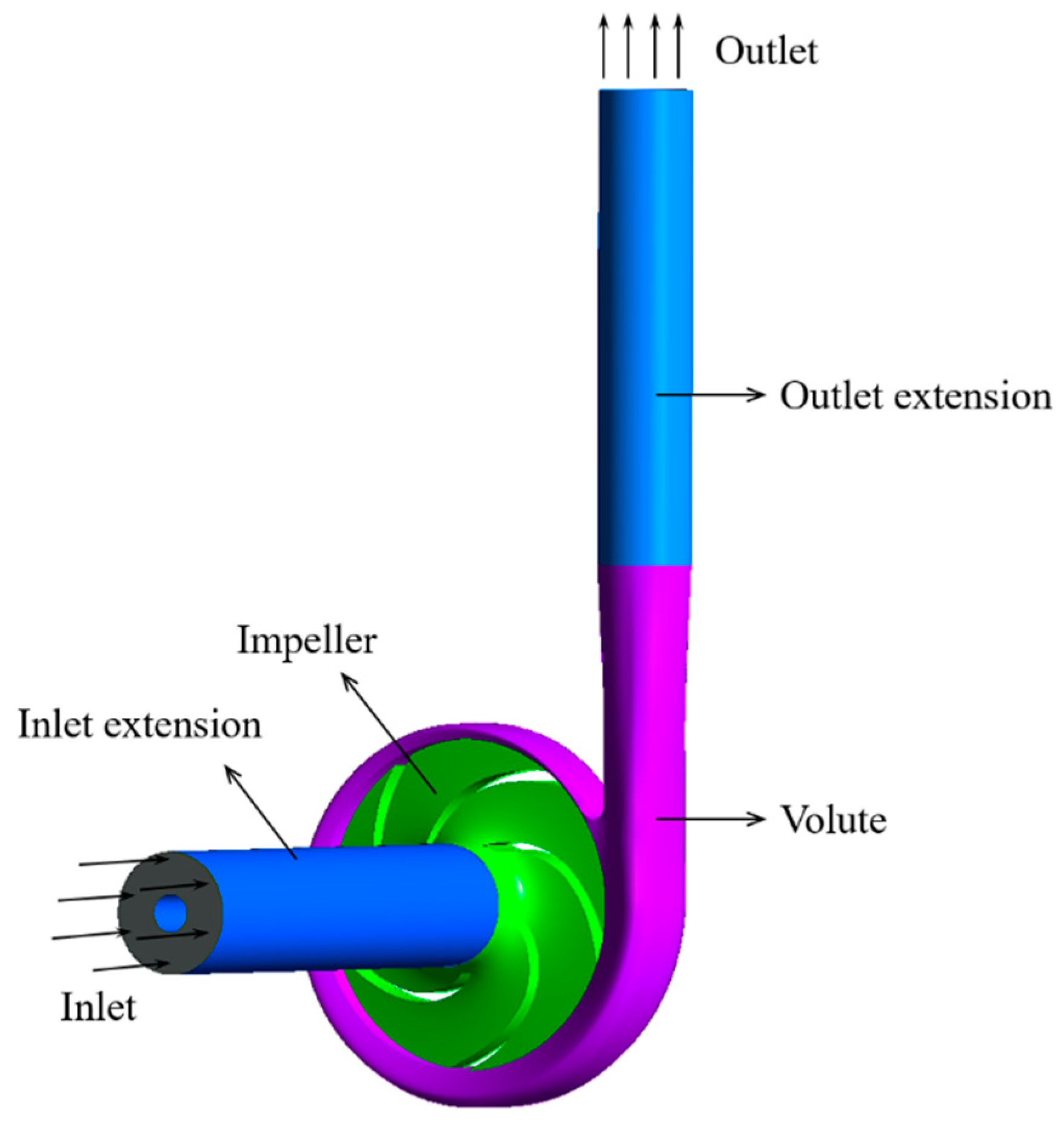
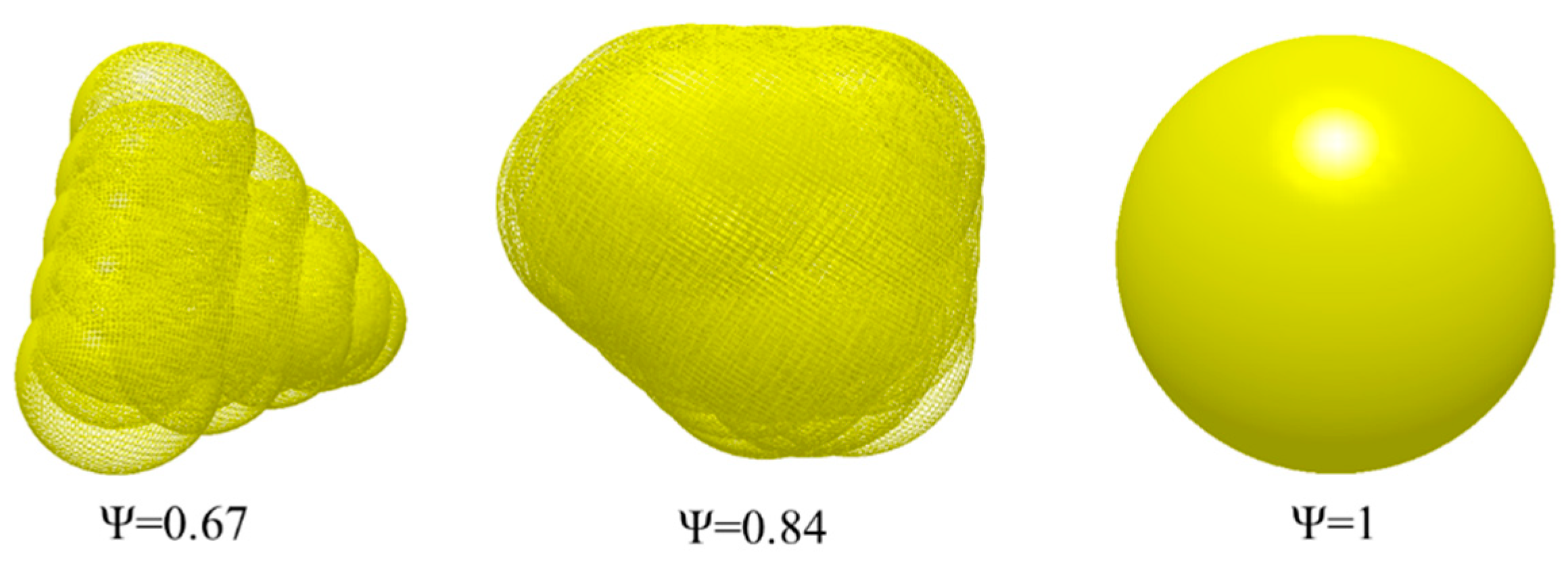
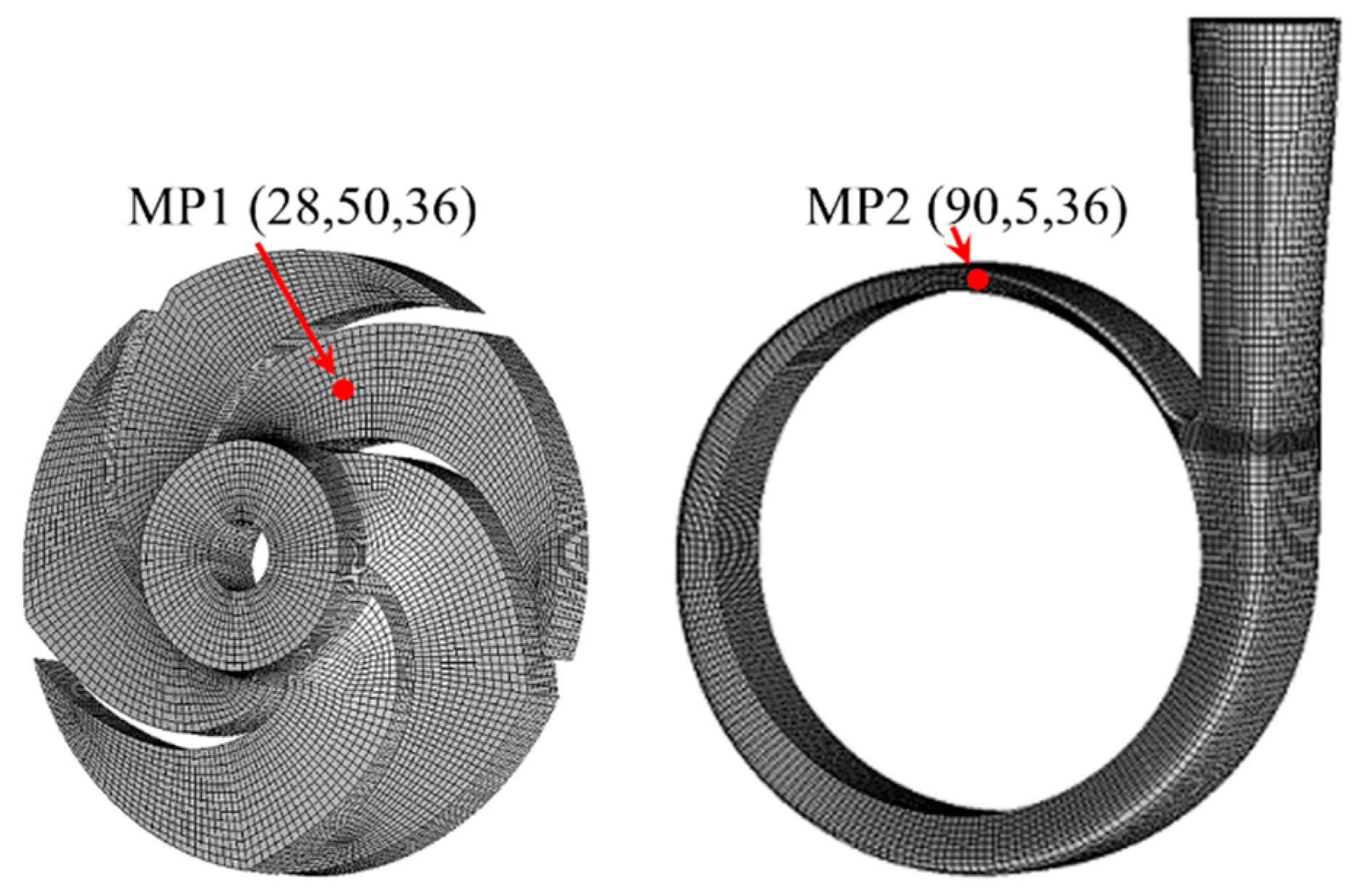

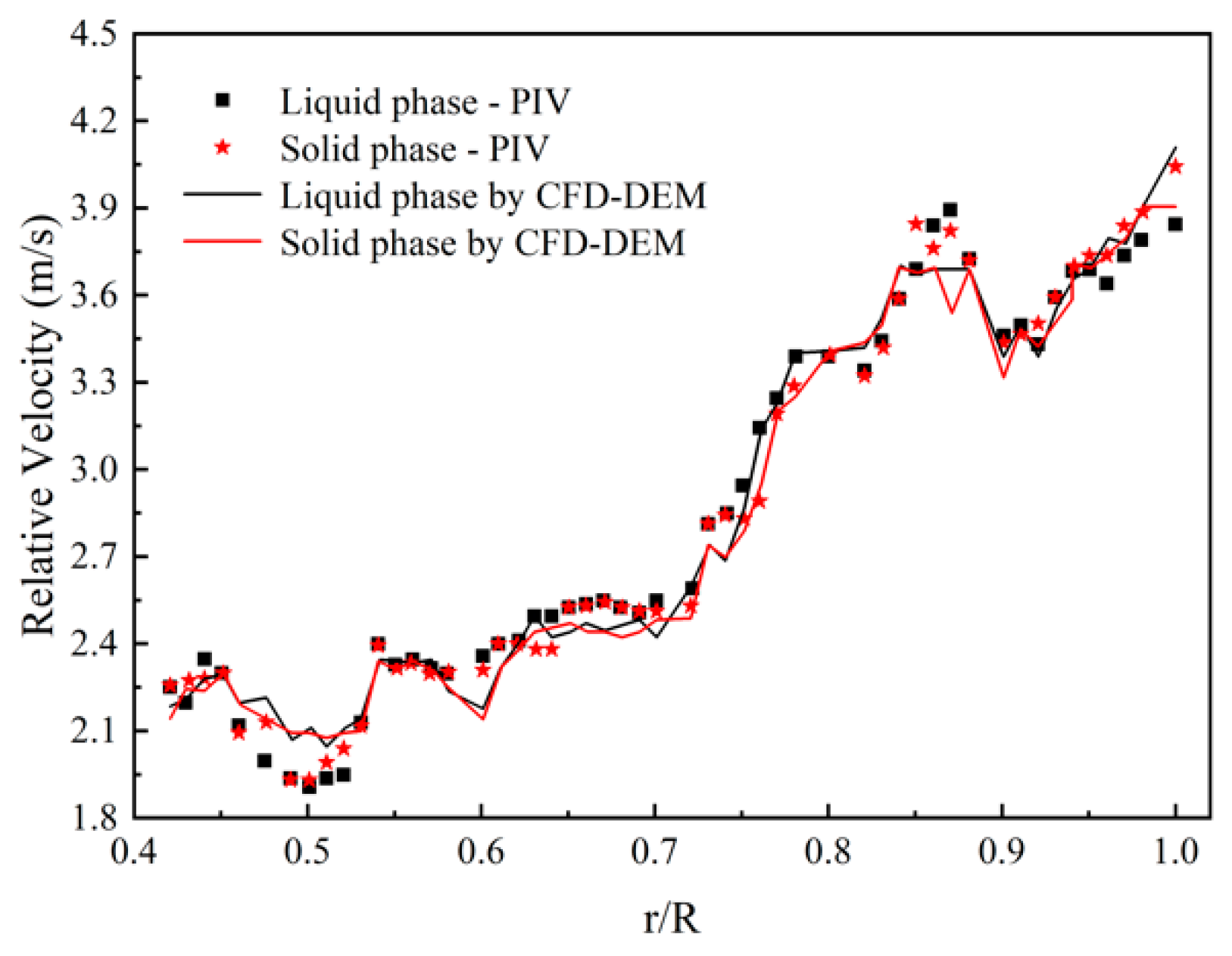

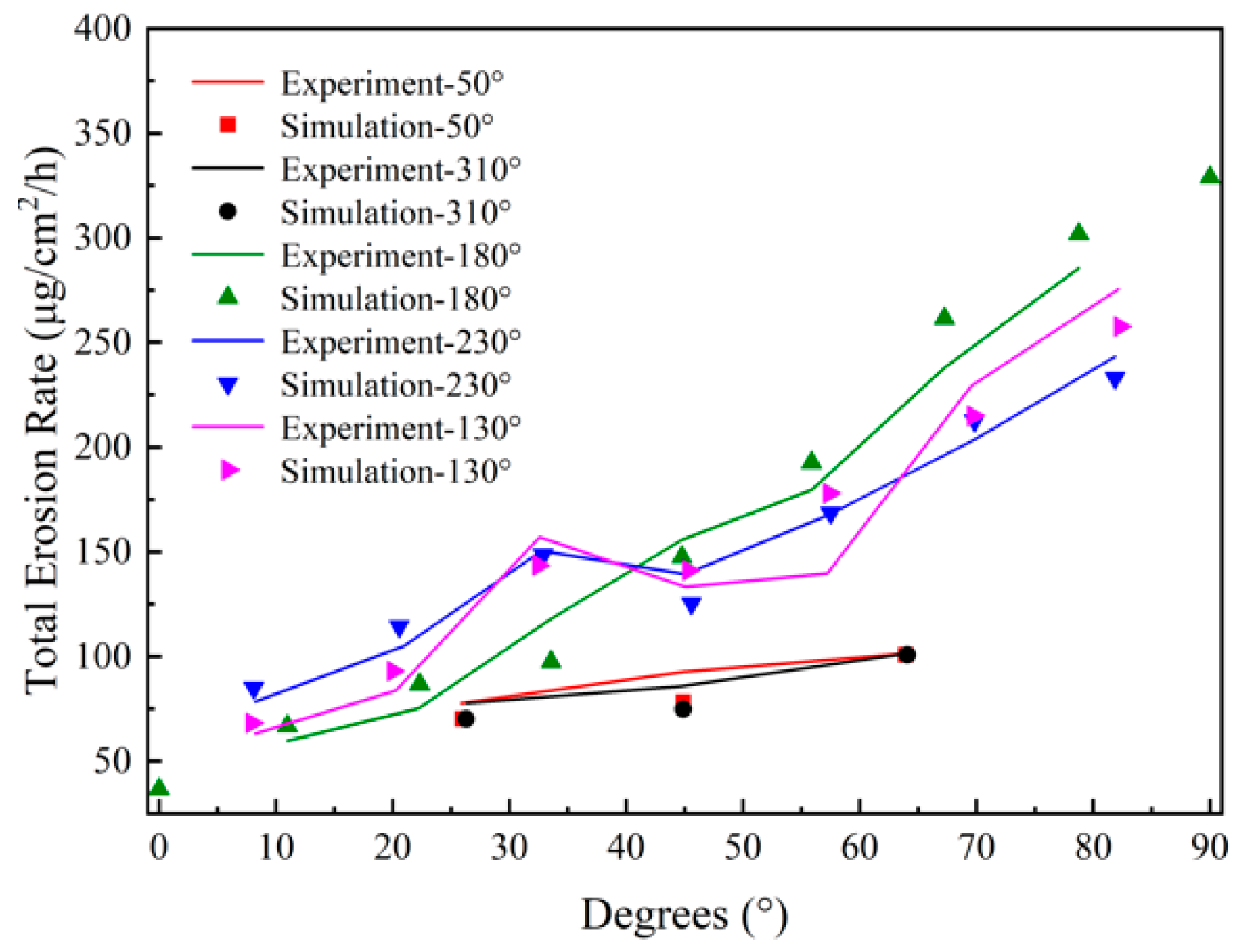
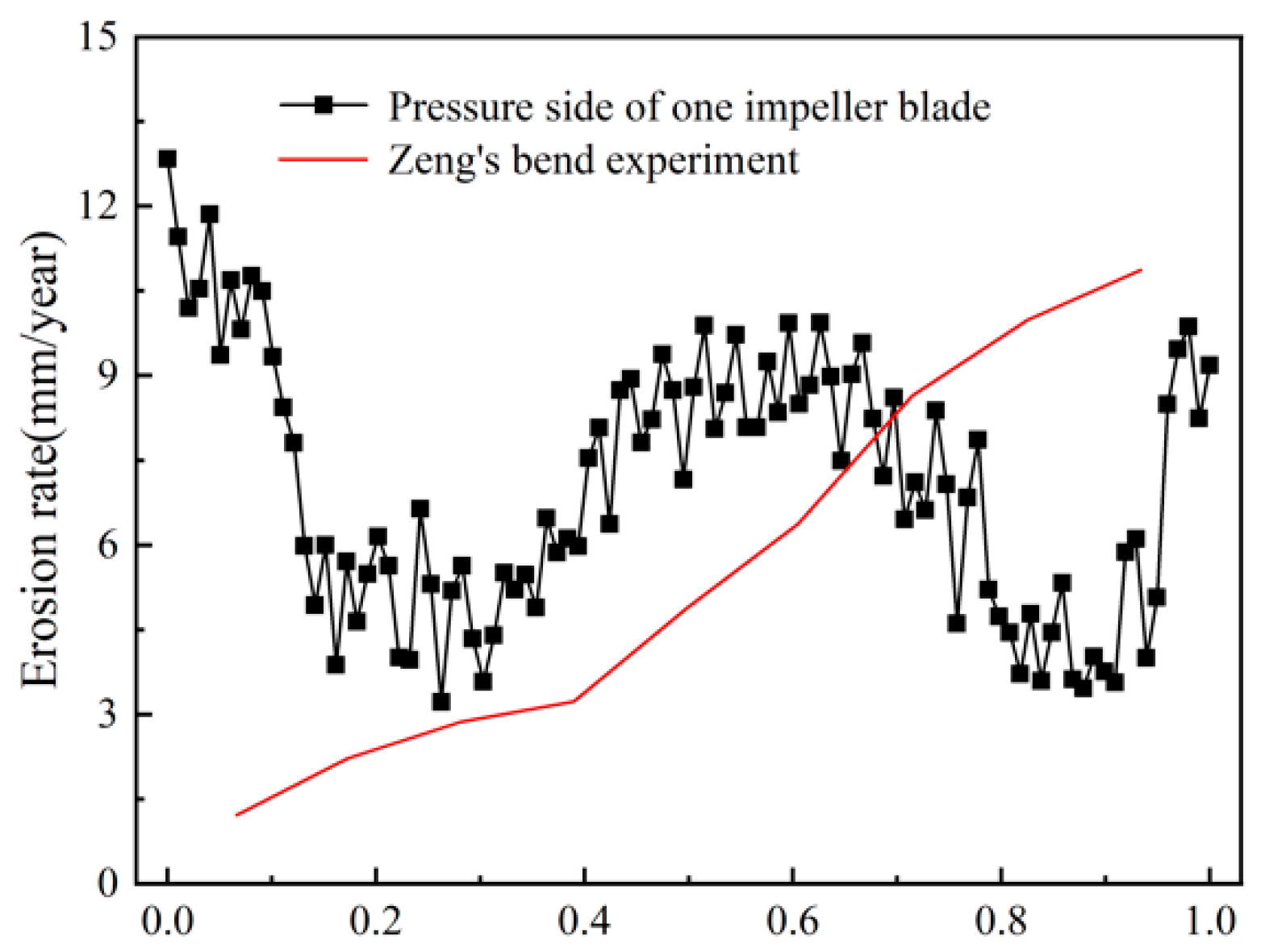
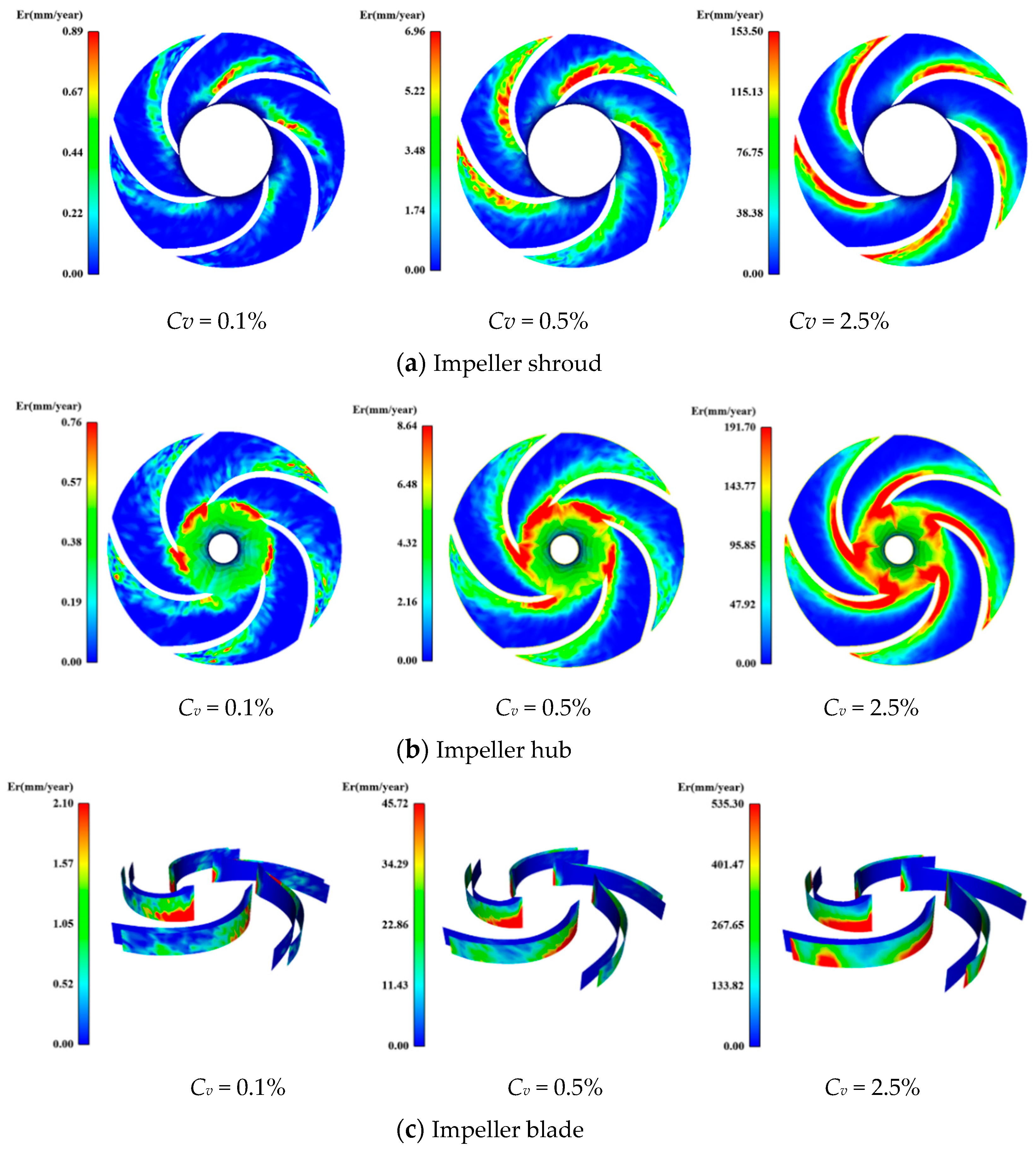
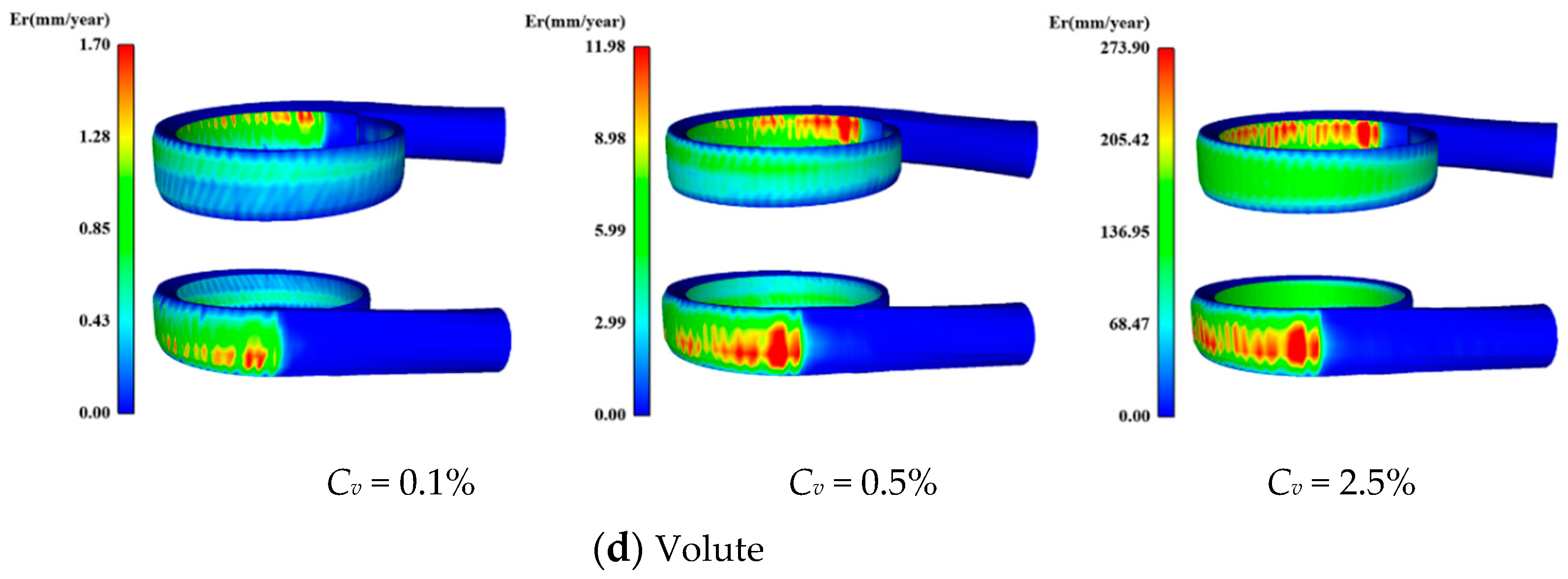

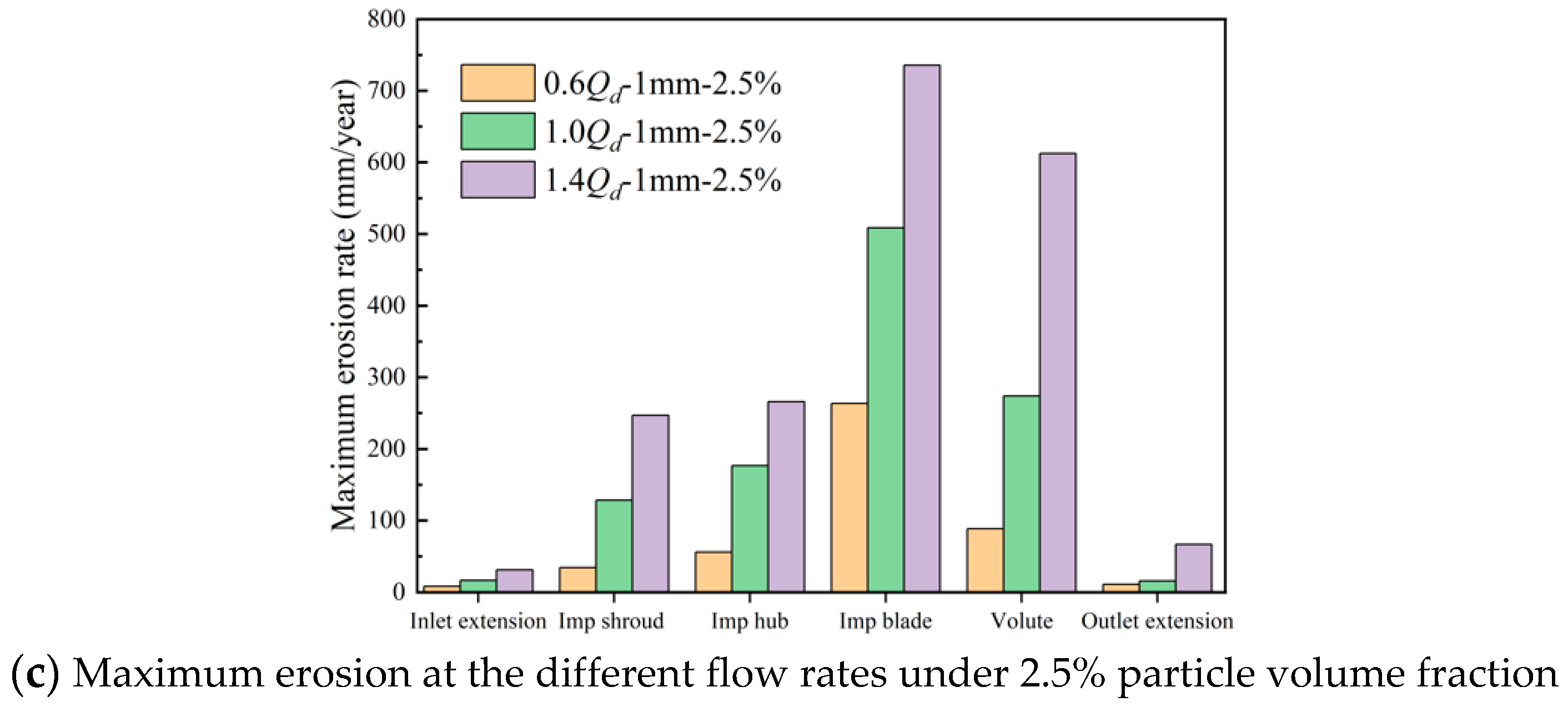
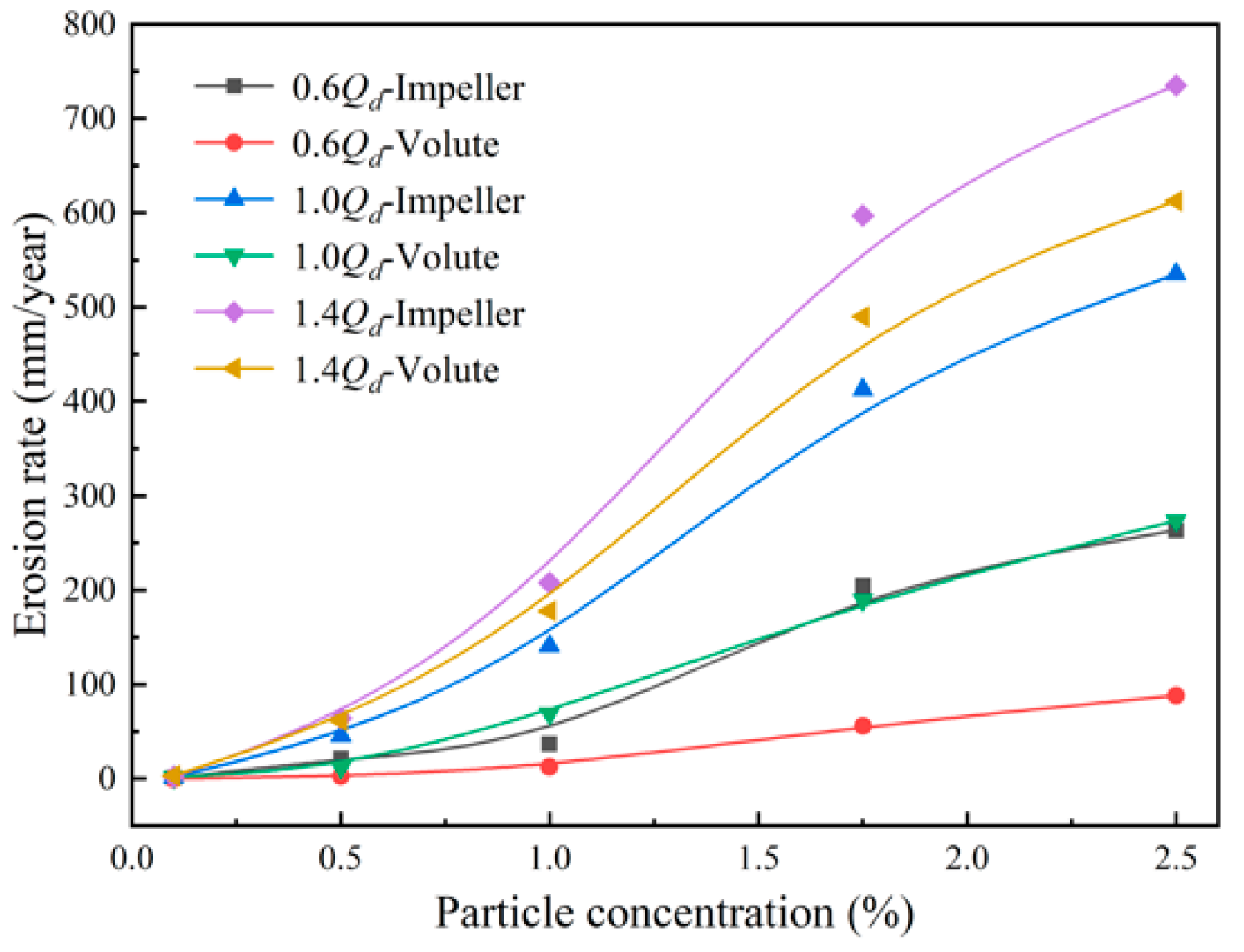
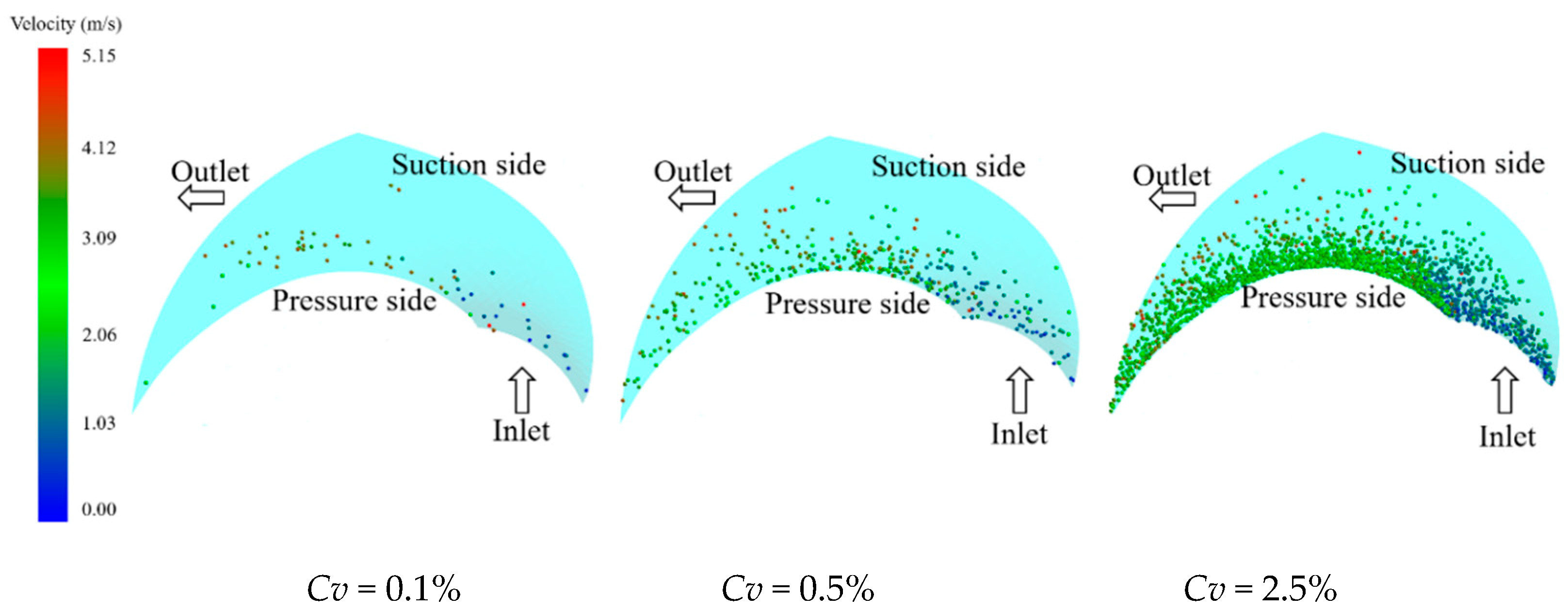
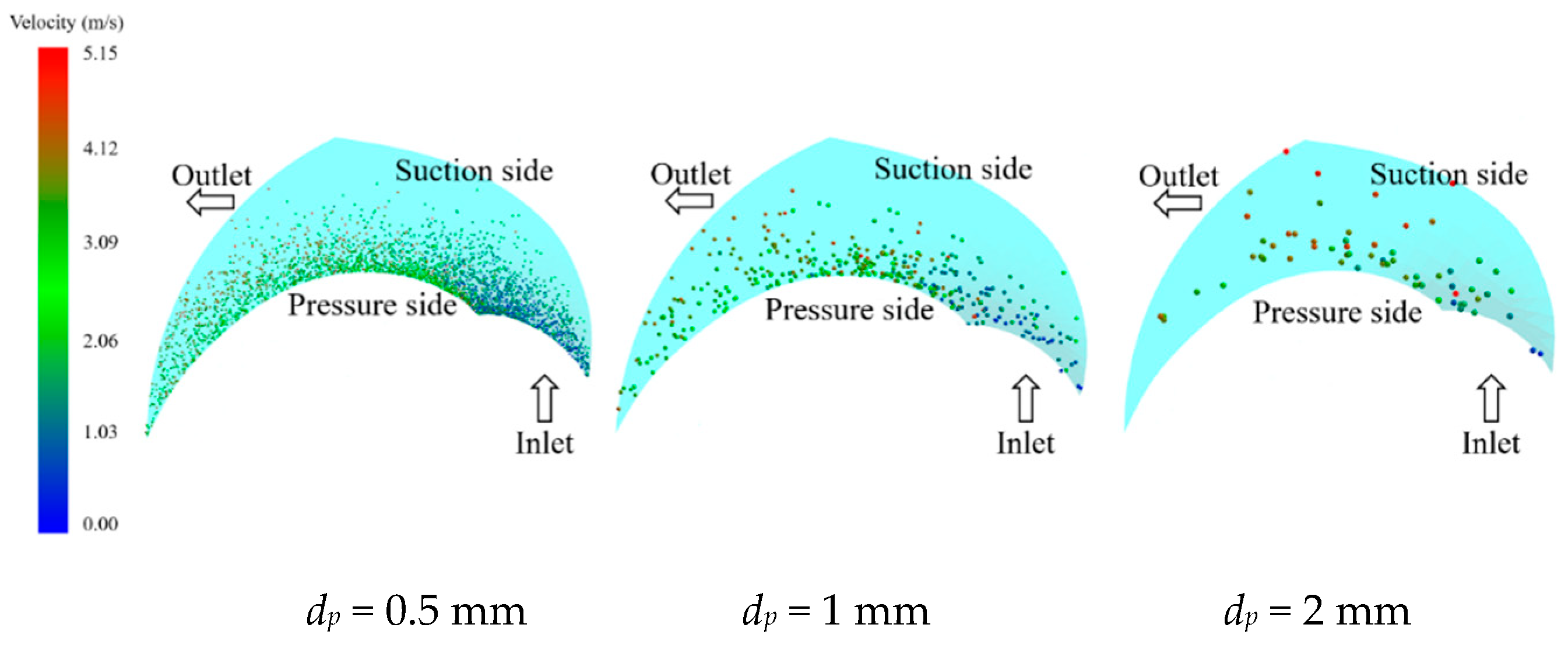
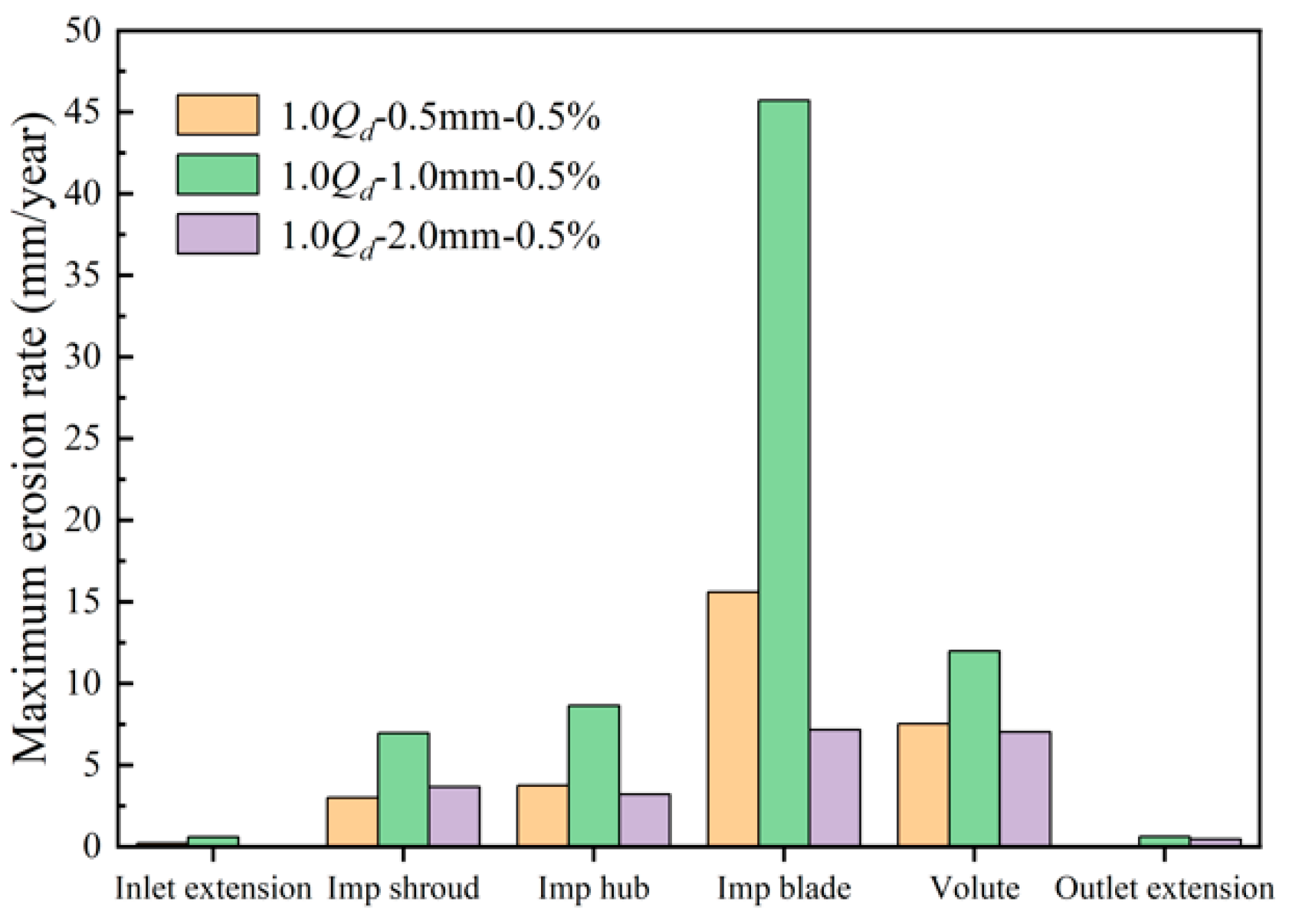
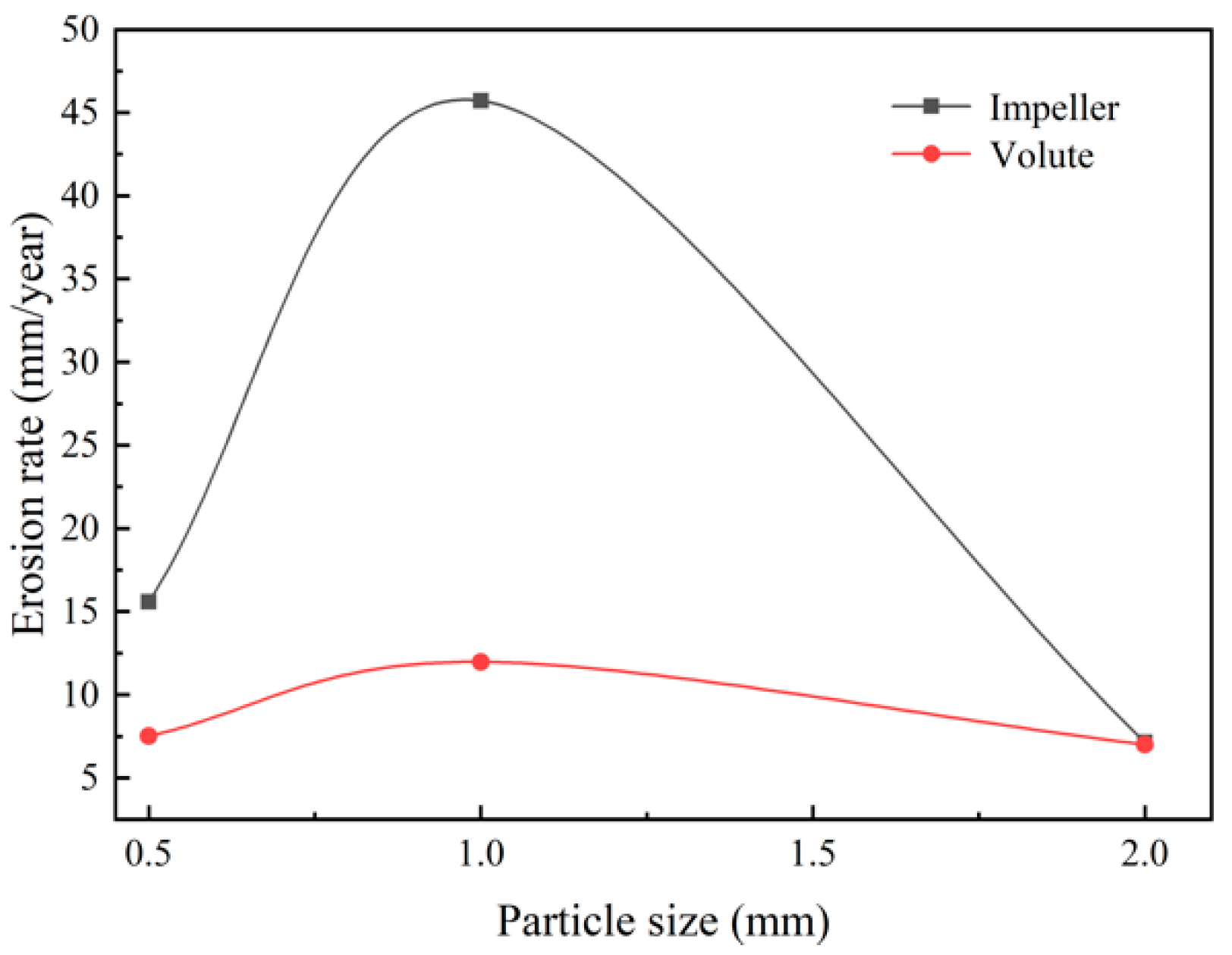
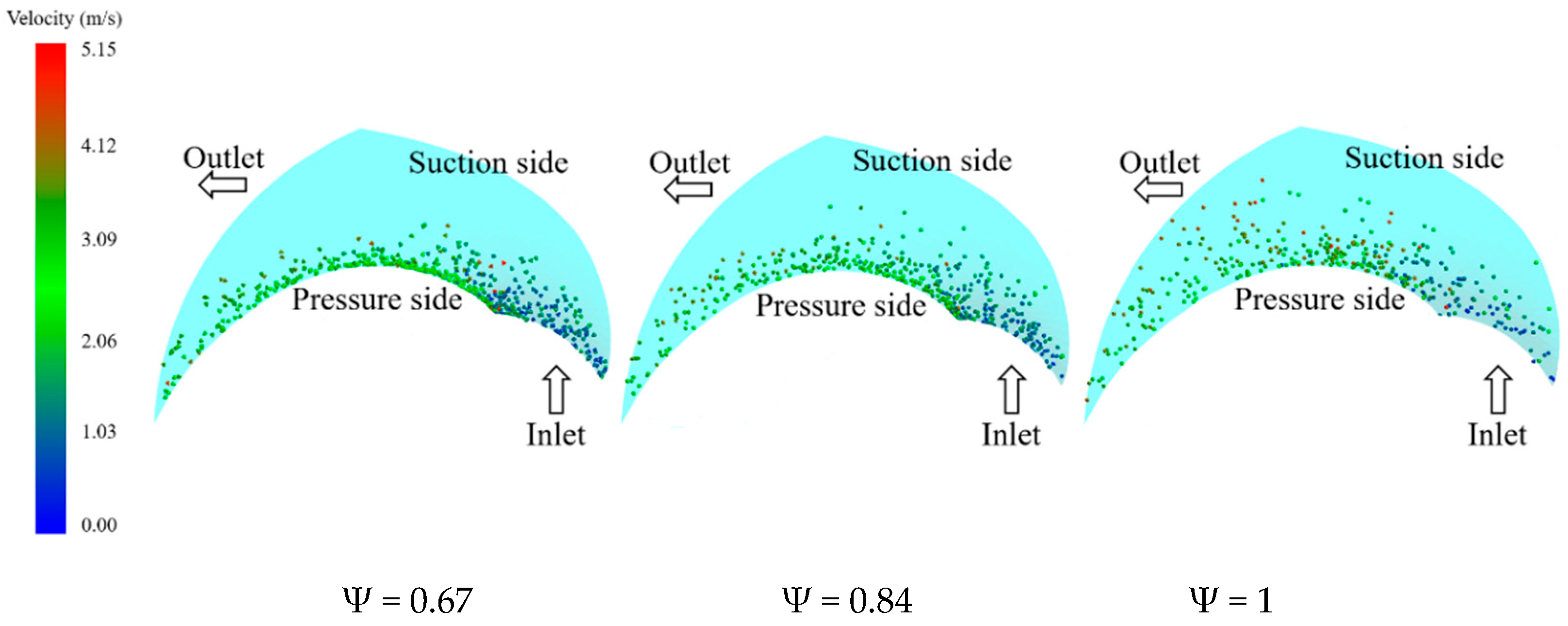
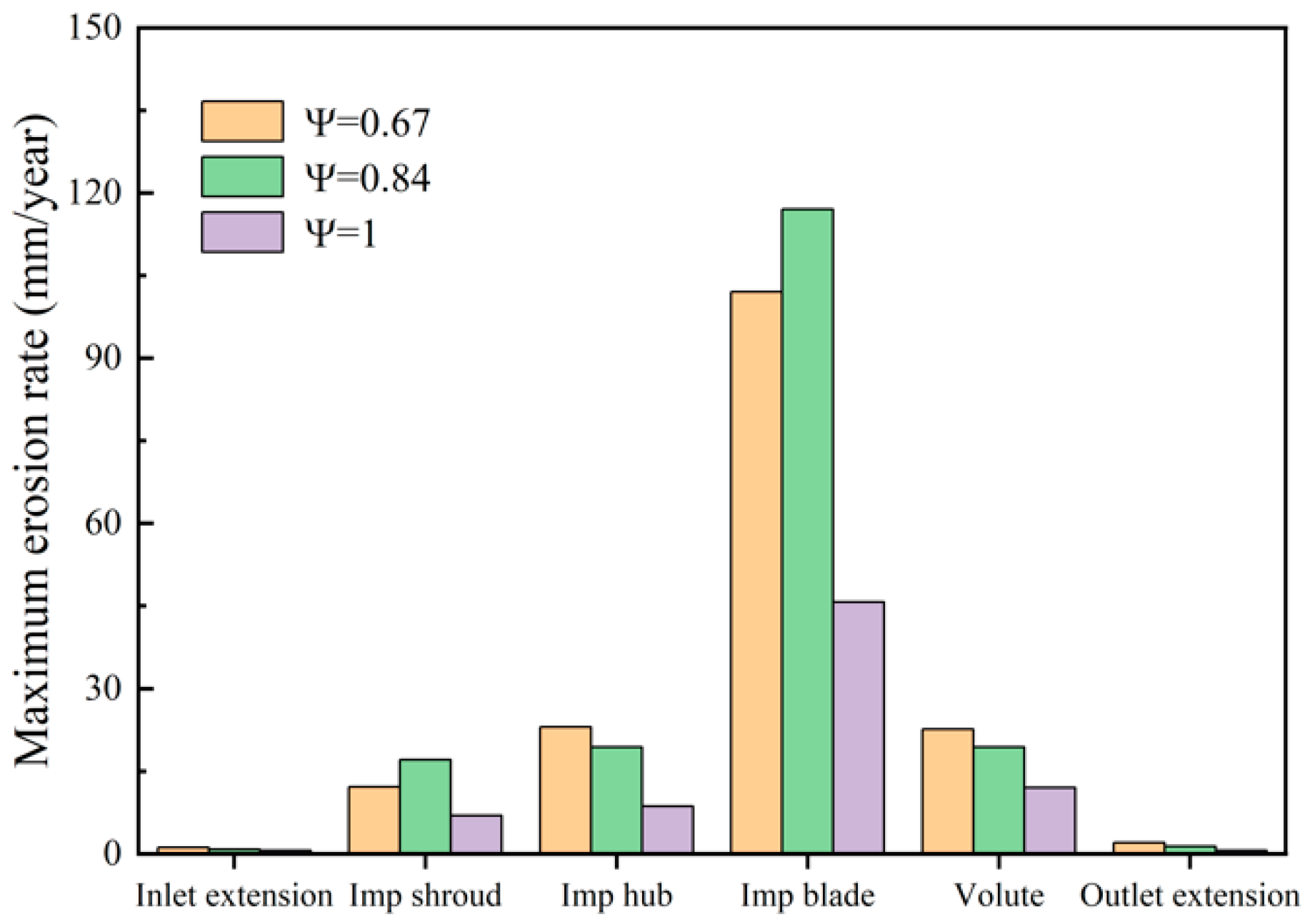

| Pump Parameters, Unit | Value |
|---|---|
| Pump head, m | 4 |
| Rated flow rate, m3/h | 15 |
| Rotation speed, rpm | 900 |
| Number of impeller blades | 5 |
| Diameter of the pump inlet, mm | 65 |
| Axis diameter, mm | 25 |
| Outlet width of impeller, mm | 18 |
| Shaft diameter, mm | 25 |
| Impeller diameter, mm | 180 |
| Mesh Number | #1 | #2 | #3 |
|---|---|---|---|
| Element number | 383,054 | 1,303,650 | 4,633,082 |
| Pump head, m | 4.54 | 4.46 | 4.47 |
| Pressure at MP1 in impeller, Pa | 1.58 × 104 | 1.42 × 104 | 1.41 × 104 |
| Velocity at MP1 in impeller, m/s | 3.32 | 3.26 | 3.28 |
| Pressure at MP2 in volute, Pa | 3.26 × 104 | 3.12 × 104 | 3.14 × 104 |
| Velocity at MP2 in volute, m/s | 5.58 | 5.43 | 5.41 |
| Physical Quantities | Value | |
|---|---|---|
| Particles | Density | 2650 kg/m3 |
| Diameter | 0.5 mm | |
| Poisson’s ratio | 0.23 | |
| Young’s modulus | 5.9 × 1010 Pa | |
| Conveying velocity | 4 m/s | |
| Mass flow rate | 0.235 kg/s | |
| Wall | Density | 8200 kg/m3 |
| Hardness | 3.43 GP | |
| Poisson’s ratio | 0.3 | |
| Young’s modulus | 200 GPa |
Publisher’s Note: MDPI stays neutral with regard to jurisdictional claims in published maps and institutional affiliations. |
© 2021 by the authors. Licensee MDPI, Basel, Switzerland. This article is an open access article distributed under the terms and conditions of the Creative Commons Attribution (CC BY) license (https://creativecommons.org/licenses/by/4.0/).
Share and Cite
Zhao, R.-J.; Zhao, Y.-L.; Zhang, D.-S.; Li, Y.; Geng, L.-L. Numerical Investigation of the Characteristics of Erosion in a Centrifugal Pump for Transporting Dilute Particle-Laden Flows. J. Mar. Sci. Eng. 2021, 9, 961. https://doi.org/10.3390/jmse9090961
Zhao R-J, Zhao Y-L, Zhang D-S, Li Y, Geng L-L. Numerical Investigation of the Characteristics of Erosion in a Centrifugal Pump for Transporting Dilute Particle-Laden Flows. Journal of Marine Science and Engineering. 2021; 9(9):961. https://doi.org/10.3390/jmse9090961
Chicago/Turabian StyleZhao, Rui-Jie, You-Long Zhao, De-Sheng Zhang, Yan Li, and Lin-Lin Geng. 2021. "Numerical Investigation of the Characteristics of Erosion in a Centrifugal Pump for Transporting Dilute Particle-Laden Flows" Journal of Marine Science and Engineering 9, no. 9: 961. https://doi.org/10.3390/jmse9090961
APA StyleZhao, R.-J., Zhao, Y.-L., Zhang, D.-S., Li, Y., & Geng, L.-L. (2021). Numerical Investigation of the Characteristics of Erosion in a Centrifugal Pump for Transporting Dilute Particle-Laden Flows. Journal of Marine Science and Engineering, 9(9), 961. https://doi.org/10.3390/jmse9090961






